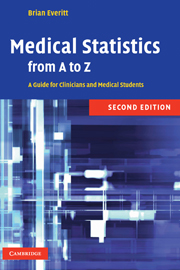H
Published online by Cambridge University Press: 23 December 2009
Summary
H0: Symbol for null hypothesis.
H1: Symbol for alternative hypothesis.
HALE: Abbreviation for health-adjusted life expectancy.
Halo effect: The tendency of a subject's performance on some task to be overrated because of the observer's perception of the subject doing well gained in an earlier exercise or when assessed in a different area. For example, a student who has made a good overall impression on a teacher may be rated as producing high-quality work and always meeting deadlines even when the work is relatively substandard. [Journal of Applied Psychology, 1920, IV, 25–9.]
Hanging rootogram: A diagram comparing an observed rootogram with a fitted curve, in which differences between the two are displayed in relation to the horizontal axis rather than to the curve itself. This makes it easier to spot large differences and to look for patterns. An example is shown in Figure 46. [Tukey, J.W., 1977, Exploratory Data Analysis, Addison-Wesley, Reading, MA.]
Haplotype: A combination of two or more alleles that are present in the same gamete. [Sham, P., 1998, Statistics in Human Genetics, Arnold, London.]
Haplotype analysis: The analysis of haplotype frequencies in one or more populations, with the aim of establishing associations between two or more alleles, or between a haplotype and a phenotypic trait, or establishing the genetic relationship between populations. [American Journal of Human Genetics, 1987, 41, 356–73.]
- Type
- Chapter
- Information
- Medical Statistics from A to ZA Guide for Clinicians and Medical Students, pp. 110 - 117Publisher: Cambridge University PressPrint publication year: 2006



